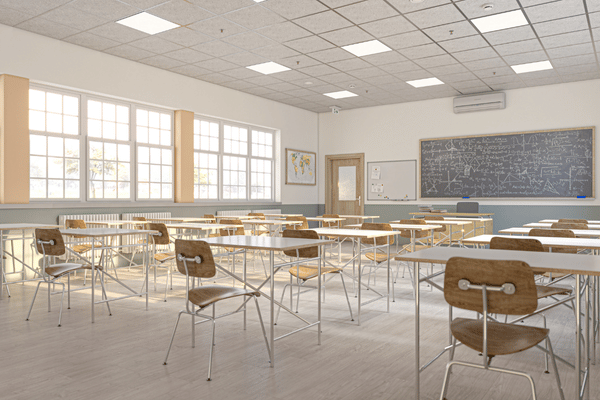BLOG

Architecture: The Role of Natural Light in Educational Building Design
Have you ever walked into a room flooded with natural light and felt instantly uplifted? Now, imagine that same feeling in an educational setting. How does natural light influence student performance, well-being, and the overall learning environment? Can architectural design harness this powerful element to create spaces that foster better education? This article explores the pivotal role of natural light in educational building design and how it can transform learning spaces.
The Importance of Natural Light in Educational Spaces
Enhancing Learning and Concentration
Natural light is more than just an aesthetic feature; it significantly impacts learning and concentration. Studies have shown that students exposed to ample natural light demonstrate improved academic performance. The reason? Natural light helps regulate circadian rhythms, ensuring students are more alert and focused during school hours. Moreover, classrooms filled with daylight reduce the need for artificial lighting, creating a more comfortable and less distracting environment.
Boosting Mental and Physical Well-being
Natural light has profound effects on both mental and physical health. In educational settings, it can reduce stress and anxiety among students, contributing to a more positive learning atmosphere. Additionally, exposure to natural light can enhance mood and energy levels, crucial for both students and educators. Physical benefits include increased vitamin D levels, which are essential for bone health and immune function.
Design Strategies for Maximising Natural Light
Orientation and Placement of Buildings
One of the fundamental principles in optimising natural light is the orientation and placement of buildings. Architects should design educational buildings with an east-west orientation to maximize sunlight exposure throughout the day. South-facing windows, in particular, can provide consistent and balanced natural light, reducing glare and shadows.
Use of Skylights and Atriums
Incorporating skylights and atriums is an effective way to bring natural light into the heart of a building. Skylights can illuminate corridors and common areas, creating inviting spaces for collaboration and social interaction. Atriums, on the other hand, can serve as central gathering spots, flooded with natural light, fostering a sense of community and openness.
Window Design and Placement
The design and placement of windows play a crucial role in harnessing natural light. Large, strategically placed windows can significantly brighten classrooms and reduce the need for artificial lighting. Additionally, the use of high-performance glazing can minimise heat gain and loss, ensuring comfort and energy efficiency.
Innovative Technologies and Materials

Daylight Harvesting Systems
Daylight harvesting systems are innovative solutions that adjust artificial lighting based on the availability of natural light. These systems use sensors to measure the amount of daylight and dim or brighten artificial lights accordingly, ensuring optimal illumination levels while conserving energy.
Light Shelves and Reflective Surfaces
Light shelves and reflective surfaces can enhance the distribution of natural light within a building. Light shelves are horizontal surfaces mounted above windows, reflecting daylight deeper into the interior spaces. Similarly, reflective surfaces, such as white ceilings and walls, can amplify the reach of natural light, reducing the need for additional lighting fixtures.
The Impact of LEED-Certified Schools
LEED-certified schools, which emphasise sustainability and energy efficiency, often incorporate extensive natural lighting. These schools not only achieve significant energy savings but also provide healthier and more stimulating learning environments. The Green School in Bali, Indonesia, is a prime example, where natural lighting and sustainable practices are central to its design, resulting in a unique and effective educational experience.
Challenges and Considerations
Balancing Natural Light with Energy Efficiency
While natural light offers numerous benefits, it is essential to balance it with energy efficiency. Excessive heat gain or loss through windows can lead to higher energy consumption for heating and cooling. Therefore, architects must carefully design glazing and shading systems to optimise both natural light and thermal comfort.
Addressing Glare and Visual Comfort
Glare can be a significant issue in naturally lit spaces, particularly in classrooms where screens and whiteboards are used. Using diffused light sources, such as frosted glass or light-diffusing materials, can mitigate glare and ensure visual comfort for students and teachers.
Conclusion
Natural light is a vital component in the design of educational buildings, offering numerous benefits for learning, health, and well-being. By strategically incorporating natural light through thoughtful architectural design, we can create educational spaces that inspire and nurture future generations. As we continue to explore and innovate in this field, the question remains: How will the classrooms of tomorrow harness the power of natural light to shape the minds of the future? The answer lies in the hands of architects and educators who dare to envision brighter, healthier learning environments.
FAQs:
1. How does natural light impact student performance in educational settings?
Natural light significantly enhances student performance by regulating circadian rhythms, leading to improved focus and alertness. Research indicates that students exposed to abundant natural light show better academic results, increased concentration, and higher engagement levels. This effect is attributed to the way natural light synchronises our internal body clocks, creating an optimal environment for learning and cognitive function.
2. What are the key architectural strategies for maximising natural light in schools?
Architectural strategies for maximising natural light in schools include optimal building orientation, strategic window placement, and the use of skylights and atriums. An east-west building orientation allows for consistent sunlight throughout the day, while large, well-placed windows reduce the need for artificial lighting. Skylights and atriums can illuminate common areas, creating inviting, naturally lit spaces. Additionally, light shelves and reflective surfaces help distribute light more effectively within interior spaces.
3. Are there any innovative technologies that can enhance the use of natural light in educational buildings?
Yes, several innovative technologies can enhance the use of natural light in educational buildings. Daylight harvesting systems, for instance, adjust artificial lighting based on the availability of natural light, ensuring optimal illumination while conserving energy. High-performance glazing minimises heat gain and loss, maintaining comfort and efficiency. Moreover, integrating light shelves and reflective surfaces can improve the distribution and intensity of natural light throughout a building.
4. What are the potential challenges of incorporating natural light into educational building design?
Incorporating natural light into educational building design can present challenges such as balancing natural light with energy efficiency and addressing glare. Excessive heat gain or loss through windows can increase energy consumption for heating and cooling. Therefore, it is crucial to design appropriate glazing and shading systems. Additionally, managing glare is essential to ensure visual comfort for students and teachers. This can be achieved through the use of diffused light sources and light-diffusing materials.

Architecture: The Role of Natural Light in Educational Building Design
Have you ever walked into a room flooded with natural light and felt instantly uplifted? Now, imagine that same feeling in an educational setting. How does natural light influence student performance, well-being, and the overall learning environment? Can architectural design harness this powerful element to create spaces that foster better education? This article explores the pivotal role of natural light in educational building design and how it can transform learning spaces.
The Importance of Natural Light in Educational Spaces
Enhancing Learning and Concentration
Natural light is more than just an aesthetic feature; it significantly impacts learning and concentration. Studies have shown that students exposed to ample natural light demonstrate improved academic performance. The reason? Natural light helps regulate circadian rhythms, ensuring students are more alert and focused during school hours. Moreover, classrooms filled with daylight reduce the need for artificial lighting, creating a more comfortable and less distracting environment.
Boosting Mental and Physical Well-being
Natural light has profound effects on both mental and physical health. In educational settings, it can reduce stress and anxiety among students, contributing to a more positive learning atmosphere. Additionally, exposure to natural light can enhance mood and energy levels, crucial for both students and educators. Physical benefits include increased vitamin D levels, which are essential for bone health and immune function.
Design Strategies for Maximising Natural Light
Orientation and Placement of Buildings
One of the fundamental principles in optimising natural light is the orientation and placement of buildings. Architects should design educational buildings with an east-west orientation to maximize sunlight exposure throughout the day. South-facing windows, in particular, can provide consistent and balanced natural light, reducing glare and shadows.
Use of Skylights and Atriums
Incorporating skylights and atriums is an effective way to bring natural light into the heart of a building. Skylights can illuminate corridors and common areas, creating inviting spaces for collaboration and social interaction. Atriums, on the other hand, can serve as central gathering spots, flooded with natural light, fostering a sense of community and openness.
Window Design and Placement
The design and placement of windows play a crucial role in harnessing natural light. Large, strategically placed windows can significantly brighten classrooms and reduce the need for artificial lighting. Additionally, the use of high-performance glazing can minimise heat gain and loss, ensuring comfort and energy efficiency.
Innovative Technologies and Materials

Daylight Harvesting Systems
Daylight harvesting systems are innovative solutions that adjust artificial lighting based on the availability of natural light. These systems use sensors to measure the amount of daylight and dim or brighten artificial lights accordingly, ensuring optimal illumination levels while conserving energy.
Light Shelves and Reflective Surfaces
Light shelves and reflective surfaces can enhance the distribution of natural light within a building. Light shelves are horizontal surfaces mounted above windows, reflecting daylight deeper into the interior spaces. Similarly, reflective surfaces, such as white ceilings and walls, can amplify the reach of natural light, reducing the need for additional lighting fixtures.
The Impact of LEED-Certified Schools
LEED-certified schools, which emphasise sustainability and energy efficiency, often incorporate extensive natural lighting. These schools not only achieve significant energy savings but also provide healthier and more stimulating learning environments. The Green School in Bali, Indonesia, is a prime example, where natural lighting and sustainable practices are central to its design, resulting in a unique and effective educational experience.
Challenges and Considerations
Balancing Natural Light with Energy Efficiency
While natural light offers numerous benefits, it is essential to balance it with energy efficiency. Excessive heat gain or loss through windows can lead to higher energy consumption for heating and cooling. Therefore, architects must carefully design glazing and shading systems to optimise both natural light and thermal comfort.
Addressing Glare and Visual Comfort
Glare can be a significant issue in naturally lit spaces, particularly in classrooms where screens and whiteboards are used. Using diffused light sources, such as frosted glass or light-diffusing materials, can mitigate glare and ensure visual comfort for students and teachers.
Conclusion
Natural light is a vital component in the design of educational buildings, offering numerous benefits for learning, health, and well-being. By strategically incorporating natural light through thoughtful architectural design, we can create educational spaces that inspire and nurture future generations. As we continue to explore and innovate in this field, the question remains: How will the classrooms of tomorrow harness the power of natural light to shape the minds of the future? The answer lies in the hands of architects and educators who dare to envision brighter, healthier learning environments.
FAQs:
1. How does natural light impact student performance in educational settings?
Natural light significantly enhances student performance by regulating circadian rhythms, leading to improved focus and alertness. Research indicates that students exposed to abundant natural light show better academic results, increased concentration, and higher engagement levels. This effect is attributed to the way natural light synchronises our internal body clocks, creating an optimal environment for learning and cognitive function.
2. What are the key architectural strategies for maximising natural light in schools?
Architectural strategies for maximising natural light in schools include optimal building orientation, strategic window placement, and the use of skylights and atriums. An east-west building orientation allows for consistent sunlight throughout the day, while large, well-placed windows reduce the need for artificial lighting. Skylights and atriums can illuminate common areas, creating inviting, naturally lit spaces. Additionally, light shelves and reflective surfaces help distribute light more effectively within interior spaces.
3. Are there any innovative technologies that can enhance the use of natural light in educational buildings?
Yes, several innovative technologies can enhance the use of natural light in educational buildings. Daylight harvesting systems, for instance, adjust artificial lighting based on the availability of natural light, ensuring optimal illumination while conserving energy. High-performance glazing minimises heat gain and loss, maintaining comfort and efficiency. Moreover, integrating light shelves and reflective surfaces can improve the distribution and intensity of natural light throughout a building.
4. What are the potential challenges of incorporating natural light into educational building design?
Incorporating natural light into educational building design can present challenges such as balancing natural light with energy efficiency and addressing glare. Excessive heat gain or loss through windows can increase energy consumption for heating and cooling. Therefore, it is crucial to design appropriate glazing and shading systems. Additionally, managing glare is essential to ensure visual comfort for students and teachers. This can be achieved through the use of diffused light sources and light-diffusing materials.
FAQS
What services do EE Architects in Chiswick West London typically offer?
At EE Architects in Chiswick, West London we offer a comprehensive range of services including residential and commercial architecture, interior design, educational building design, and renovations. We provide consultations to understand client needs, create detailed design plans, and manage the entire construction process. EE-Architects excels in these areas, ensuring each project is tailored to meet specific client requirements with a focus on sustainability and innovation.
How do I choose the best architects in West London for my project?
Choosing the best architects in Chiswick, West London or beyond involves evaluating their experience, portfolio, and client reviews. It's important to select an architect who understands your vision and can provide tailored solutions. EE-Architects stands out due to its extensive experience, innovative designs, and commitment to sustainable practices, making it an excellent choice for various architectural projects.
What should I expect during an architectural consultation with EE Architects in Chiswick?
During an architectural consultation with one of our experts, expect to discuss your project vision, budget, and timeline. The architect will provide insights and suggestions based on their expertise. EE-Architects offers thorough consultations, ensuring a clear understanding of client needs and providing expert advice to help shape the project effectively.
Are eco-friendly architectural designs available with EE Architects?
Yes, eco-friendly architectural designs are readily available with EE Architects. These designs focus on sustainability, energy efficiency, and the use of environmentally responsible materials. EE-Architects is known for its commitment to eco-friendly architecture, integrating sustainable practices into every project to minimise environmental impact while enhancing aesthetic appeal.
Can EE Architects in Chiswick, West London handle both residential and commercial projects?
Yes, EE Architects in Chiswick, West London are equipped to handle both residential and commercial projects. We possess the expertise to design functional and aesthetically pleasing spaces for various purposes. EE-Architects offers specialised services for both sectors, ensuring that each project, whether a home or a commercial space, meets the highest standards of design and functionality.
Residential Architects
Commercial Architects
Educational Architects
Landscape Architects
Renovation Architects
Interior Design
Renovation
Construction
Master-Planning
Residential Projects
Commercial Projects
Education Project
Community Projects
International Projects

